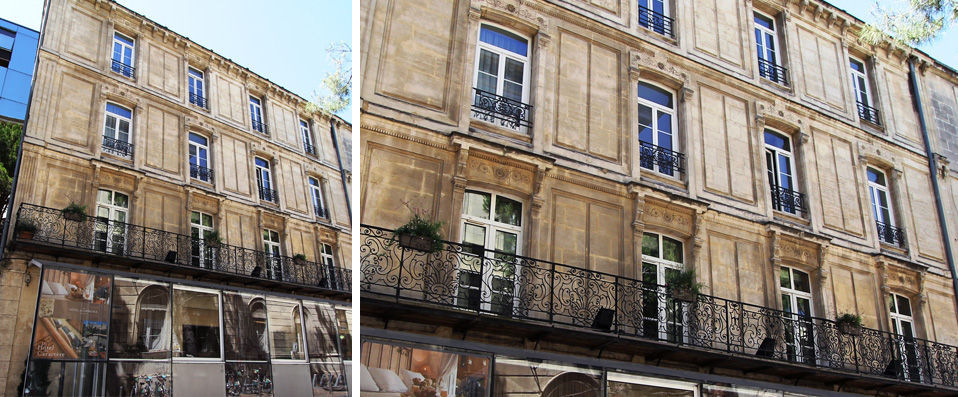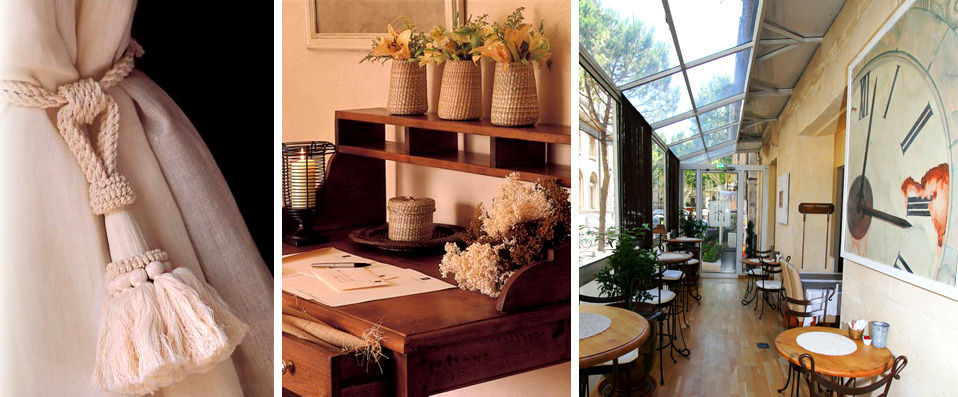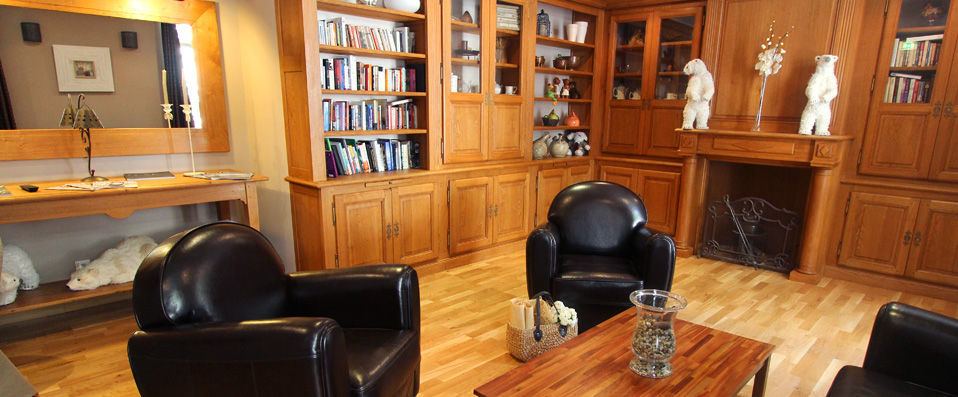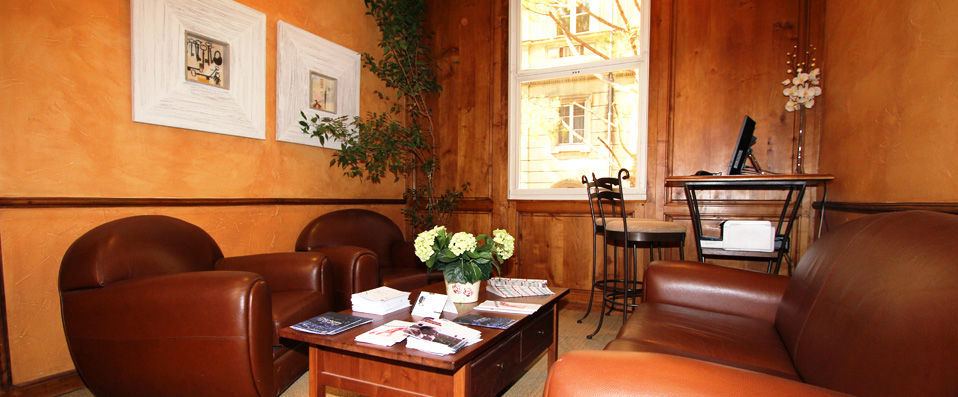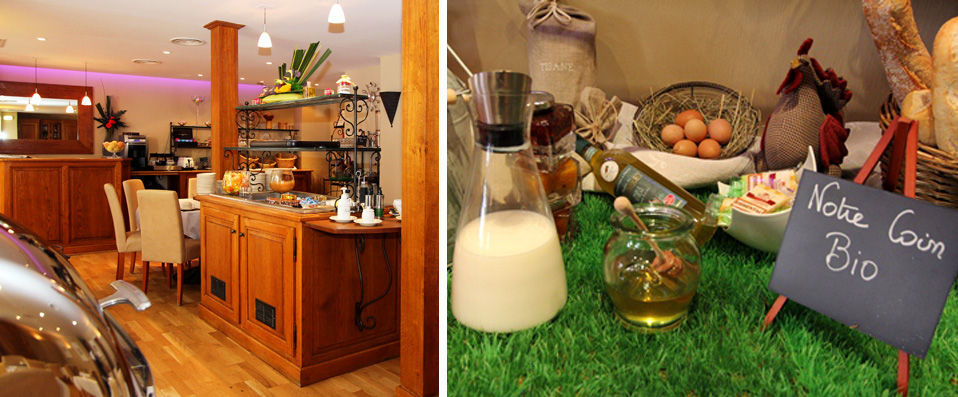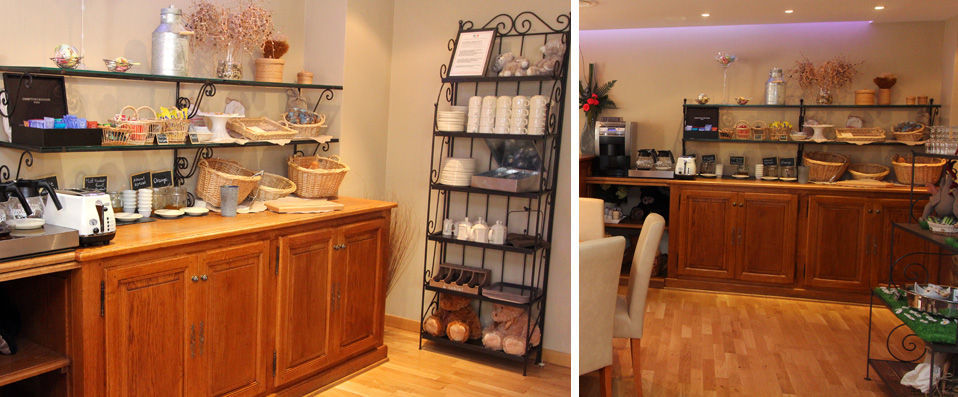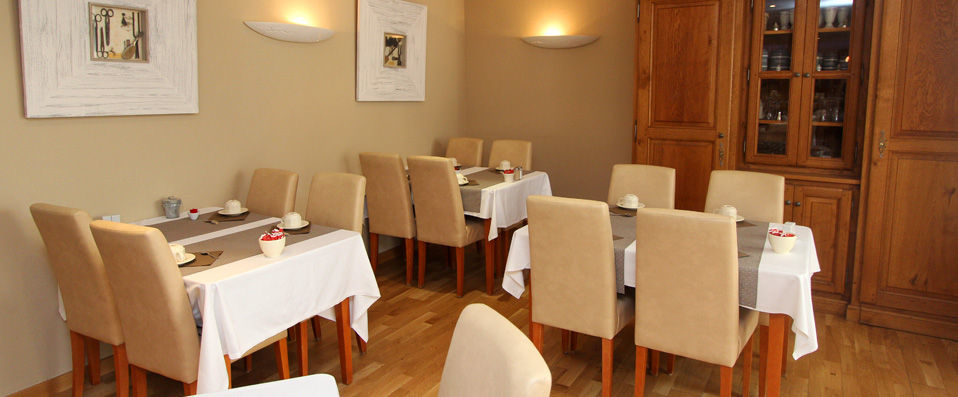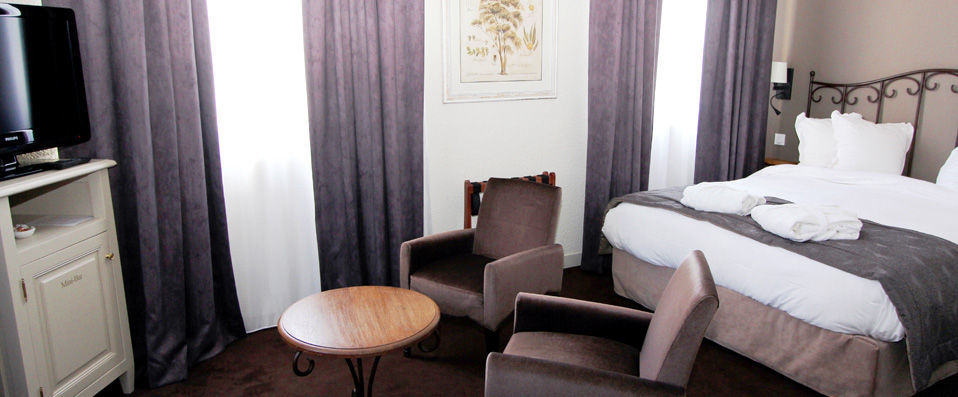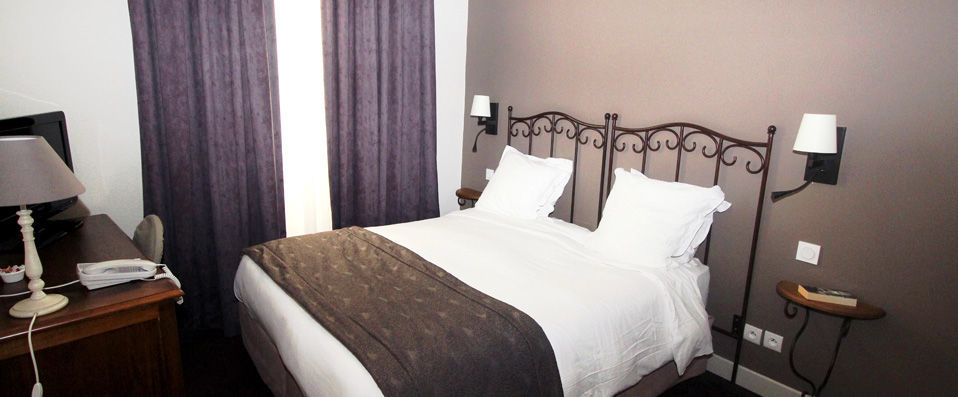This offer has ended
This flash sale is no longer available. Find all our current and upcoming sales:
View all offers The ideal location in the historic and touristic centre of Avignon, where everything is within walking distance
The ideal location in the historic and touristic centre of Avignon, where everything is within walking distance The complimentary trays of tea and coffee in the rooms so you can indulge at any time
The complimentary trays of tea and coffee in the rooms so you can indulge at any time The luxuriously comfortable bedding – the perfect remedy for legs weary from a day of exploring
The luxuriously comfortable bedding – the perfect remedy for legs weary from a day of exploring The friendly and efficient staff who possess a wealth of knowledge about the area
The friendly and efficient staff who possess a wealth of knowledge about the area The immaculate bathrooms, with separate WC
The immaculate bathrooms, with separate WC
Loading video...
Hotel de l'Horloge ★★★★
Cosy hotel in the historic centre of Avignon
By Lizzie Davey, VeryChic correspondent
Sitting pretty at the heart of France's rustic region of Provence, Avignon is an ancient city characterised by rolling ramparts, cobbled alleyways, and cosy squares. The town is reminiscent of days gone by, evident in the grandiose architecture, the palaces, and the antique shops selling curiosities from a time that has long since past. It is obvious that Avignon was once an important city, and today it retains its confident composure along with its narrow streets and leafy avenues. It’s a pocket-sized, ancient city that allows visitors a glimpse into the past from the present day, and the Hotel de L’Horloge reflects this comfortable, friendly charm throughout its rooms in the historic and touristic centre of Avignon.
Surrounded by 800-year old traditional ramparts, Avignon is a pocket of the past in the present day. With an expansive and rich cultural heritage, the city provides a hub for exploring the ancient world in one of France’s most picturesque regions. Characterised by winding, cobblestone streets and captivating boutique stores, Avignon packs a punch both with its charming atmosphere and its deep history waiting to be delved into.
I don’t know about you, but I’m a sucker for quaint cities with plenty of history embedded deep within the walls, so when I discovered that Avignon ticks both of these boxes, I couldn’t wait to step back in time and wander the streets of a city abundant with rustic, old-world overtures. Passing through the city walls, I imagined fully-armoured guards pacing backwards and forwards, weapons thrown across their shoulders, keeping an eye on the safety of Avignon. Now, that’s not really necessary, and instead the walls are a top attraction in the city, with great views across the burnt umber rooftops and grand, ochre buildings. Snippets of visions from the past came to life throughout my time in the city, as I pictured what it would have been like to live in ancient Avignon. The magnificent buildings that have stood the test of time combined with the battlements and traditional stone floors help paint the scene of a thriving medieval city, so it wasn’t difficult to imagine bustling weekend markets and the sound of horses’ hooves thundering through the streets.
Despite its big history, however, Avignon is a fairly small town saturated with quirky charisma and a homely feel, and this continues into the Hotel de L’Horloge, which sits right in the centre of all the action. It combines the charm and heritage of Avignon with the comfortable, familiar amenities of the present day, like WiFi (anyone else enjoy learning more online after a day of exploring?) and flat screen TVs (one of the reasons I’m thankful that I don’t actually live in the Middle Ages). The hotel opens out onto the Place de L’Horloge – after which it is named – and from here I walked in the footsteps of the past across the famous Bridge, which offers breathtaking views across the city, including the impressive focal point of the Palais des Papes and the great medieval fortress.
As I weaved through the streets of Avignon and, therefore, its historic timeline, I emerged into small, leafy squares where I enjoyed coffee breaks and people-watching, I dipped in and out of the many museums and galleries, and I admired the elegant townhouses and boutique shops. As I wandered, I discovered that Avignon is a relaxing, peaceful town, which nods back to a simpler way of life and a simpler time of living. Again, I was amazed to see this embodied in the Hotel de L’Horloge, too. It was as if the hotel had wrapped up the essence of Avignon and presented it across numerous rooms in a 19th Century townhouse.
The elegant charm was displayed in the rich use of colours; plum curtains, taupe bedding, and white accents; the familiar, homely feel was evident in the welcoming, helpful staff and the gloriously comfortable beds; the plush carpets provided the perfect antidote for feet that had been treading cobblestones all day; and the quirky quaintness was represented in the delightful small touches, like the tea and coffee trays carefully laid out in each room.
I have to say, the Hotel de L’Horloge was as cosy as Avignon itself, tucked tightly between the safe arms of the crumbling old ramparts. The city itself has seen many a sight in its old, fascinating life, and this emanates throughout the labyrinth of curling, twisting alleyways. I wanted a starting point for exploring the Provence region, and got so much more – I also found a starting point for exploring the charm of the medieval world, which is embodied whole-heartedly (albeit with present day highlights) in the Hotel de L’Horloge.
I don’t know about you, but I’m a sucker for quaint cities with plenty of history embedded deep within the walls, so when I discovered that Avignon ticks both of these boxes, I couldn’t wait to step back in time and wander the streets of a city abundant with rustic, old-world overtures. Passing through the city walls, I imagined fully-armoured guards pacing backwards and forwards, weapons thrown across their shoulders, keeping an eye on the safety of Avignon. Now, that’s not really necessary, and instead the walls are a top attraction in the city, with great views across the burnt umber rooftops and grand, ochre buildings. Snippets of visions from the past came to life throughout my time in the city, as I pictured what it would have been like to live in ancient Avignon. The magnificent buildings that have stood the test of time combined with the battlements and traditional stone floors help paint the scene of a thriving medieval city, so it wasn’t difficult to imagine bustling weekend markets and the sound of horses’ hooves thundering through the streets.
Despite its big history, however, Avignon is a fairly small town saturated with quirky charisma and a homely feel, and this continues into the Hotel de L’Horloge, which sits right in the centre of all the action. It combines the charm and heritage of Avignon with the comfortable, familiar amenities of the present day, like WiFi (anyone else enjoy learning more online after a day of exploring?) and flat screen TVs (one of the reasons I’m thankful that I don’t actually live in the Middle Ages). The hotel opens out onto the Place de L’Horloge – after which it is named – and from here I walked in the footsteps of the past across the famous Bridge, which offers breathtaking views across the city, including the impressive focal point of the Palais des Papes and the great medieval fortress.
As I weaved through the streets of Avignon and, therefore, its historic timeline, I emerged into small, leafy squares where I enjoyed coffee breaks and people-watching, I dipped in and out of the many museums and galleries, and I admired the elegant townhouses and boutique shops. As I wandered, I discovered that Avignon is a relaxing, peaceful town, which nods back to a simpler way of life and a simpler time of living. Again, I was amazed to see this embodied in the Hotel de L’Horloge, too. It was as if the hotel had wrapped up the essence of Avignon and presented it across numerous rooms in a 19th Century townhouse.
The elegant charm was displayed in the rich use of colours; plum curtains, taupe bedding, and white accents; the familiar, homely feel was evident in the welcoming, helpful staff and the gloriously comfortable beds; the plush carpets provided the perfect antidote for feet that had been treading cobblestones all day; and the quirky quaintness was represented in the delightful small touches, like the tea and coffee trays carefully laid out in each room.
I have to say, the Hotel de L’Horloge was as cosy as Avignon itself, tucked tightly between the safe arms of the crumbling old ramparts. The city itself has seen many a sight in its old, fascinating life, and this emanates throughout the labyrinth of curling, twisting alleyways. I wanted a starting point for exploring the Provence region, and got so much more – I also found a starting point for exploring the charm of the medieval world, which is embodied whole-heartedly (albeit with present day highlights) in the Hotel de L’Horloge.
Standard Room
Stay in a Standard Room for up to 2 adults


-
- Surface area: 14 square metres
-
- Bed Types: 1 big double bed
-
- Bathroom with shower, toilet, hair dryer and free toiletries
-
- Bedroom equipped with: view of the city, telephone, flat screen TV, radio, Satellite TV, cable TV, safe for laptop, air conditioning, heating, minibar, wake up service /alarm clock
Traditional Room
Stay in a Traditional Room for up to 2 adults


-
- Surface area: 11 to 18 square metres
-
- Bed Types: 1 big double bed
-
- Bathroom with shower, toilet, hair dryer and free toiletries
-
- Bedroom equipped with: view of the city, telephone, flat screen TV, radio, Satellite TV, cable TV, safe for laptop, air conditioning, heating, minibar, wake up service /alarm clock
Superior Room
Stay in a Superior Room for up to 2 adults


-
- Surface area: 17 to 20 square metres
-
- Bed Types: 1 big double bed
-
- Bathroom with shower, toilet, hair dryer and free toiletries
-
- Bedroom equipped with: view of the city, la Mairie (town hall) or la Place de l'Horloge, telephone, flat screen TV, radio, Satellite TV, cable TV, safe for laptop, air conditioning, heating, minibar, wake up service /alarm clock, soundproof walls
Junior Suite
Stay in a Junior Suite for up to 2 adults, 2 adults and 1 child or 3 adults


-
- Surface area: 24 to 26 square metres
-
- Bed Types: 1 big double bed
-
- Bathroom with shower, toilet, hair dryer, slippers and free toiletries
-
- Bedroom equipped with: view of the city, la Mairie (town hall) or la Place de l'Horloge, telephone, flat screen TV, radio, Satellite TV, cable TV, safe for laptop, air conditioning, heating, minibar, wake up service /alarm clock, soundproof walls and expresso machine
 24-hour reception
24-hour reception 66 Rooms - Smoking and non-smoking rooms on request
66 Rooms - Smoking and non-smoking rooms on request Meeting room & library
Meeting room & library Open access to library lounge
Open access to library lounge Free access to WI-Fi broadband in bedroom
Free access to WI-Fi broadband in bedroom Public parking nearby with discounted rates
Public parking nearby with discounted rates Tourist information
Tourist information Pets are not allowed in the establishement
Pets are not allowed in the establishement The establishment provides disabled and limited mobility access on request with confirmation
The establishment provides disabled and limited mobility access on request with confirmation
- Visit the Petit Palais, which is flanked by buildings from almost every century since the 13th, in the cobbled square of Place du Palais. Inside the former archbishop’s palace, you can wander amongst works by some of the Italian Renaissance’s greatest artists, including Botticelli, Carpaccio, and Crivelli. (Place du Palais, Avignon)
- For a treat for all the senses, take a trip to Les Halles Market, which boasts almost 50 stalls piled high with Provençal goodies, including fresh meats and cheeses, as well as more luxurious products like oysters and flavoured sea salt. Visit on a Saturday at around 11am to see a local chef demonstrating how you can use some of the fresh ingredients on display. (Place Pie, Avignon)
- For a taste of France, head to Chateauneuf-du-Pape, which is located half an hour’s drive away from Avignon, and where the eponymous wine originates from. Here you can explore a castle built by Pope John XXII and enjoy views across the old town, as well as sample different varieties of the wine by master sommelier Guy Bremond at Les Caves Saint Charles, located in the Pope’s cellar from the 13th Century.
Hotel de l'Horloge ★★★★
1-3 rue Félicien David, Place de l'Horloge
84000
Avignon
France
The Hotel de l’Horloge **** is ideally located in the heart of the historic Avignon, close to the Papal Palace, the International Congress Centre, shady café terraces and the boutiques of the city centre.
BY PLANE
 The closest major airport is Marseille-Provence Airport, about 80km (50 miles) from the hotel.
The closest major airport is Marseille-Provence Airport, about 80km (50 miles) from the hotel.
From the UK: British Airways, EasyJet and Ryanair fly from London. Seasonal flights are also operated by easyJet from Bristol, and Ryanair from Edinburgh.
From Ireland: Seasonal flights are operated by Ryanair out of Dublin.
From Germany: Air France flies from Berlin and Lufthansa fly from Frankfurt and Munich.
From Sweden: Ryanair flies seasonally from Stockholm.
From Denmark: Norwegian flies from Copenhagen.
From Finland: SAS flies seasonally from Helsinki.
From France: Air France flies directly from Paris, Biarritz and Bordeaux. You can also fly into Avignon-Caumont from Bordeaux with Ryanair and Air France. Hop! flies non-stop from Strasbourg, Lyon and Toulouse.
HOW TO GET TO THE HOTEL FROM THE AIRPORT
 By Taxi: A taxi could cost in the region of 140€, reaching 190€ at night. They can be picked up from outside the airport terminal, or reserved in advance at +33 6 25 23 13 19.
By Taxi: A taxi could cost in the region of 140€, reaching 190€ at night. They can be picked up from outside the airport terminal, or reserved in advance at +33 6 25 23 13 19.
By Train: First take the Navette Marseille Aeroport shuttle bus from the airport to the Marseille Saint Charles train station. Trains run directly from Marseille Saint Charles to Avignon Centre. It takes between 30 and 90 minutes, and tickets cost from 20.80€ per person, one way.
By Bus: There is no direct service from Marseille to Avignon. Instead, take the Navette from the airport to Aix-en-Provence, where you can pick up the Number 23 bus from Aix to Avignon. It only leaves four times a day, and could take up to four hours. For more information: http://www.info-ler.fr/en/
BY CAR
 By Car: Take the A7 towards Rognac, and take Exit 23 ‘Avignon Nord’. Follow the directions to the centre of town and go along the ramparts. On your right, you will pass the SNCF station Avignon Centre. At the traffic light on the left, you will enter the ramparts by the Porte de la République. Go up Rue de la République, and you will arrive in front of the Place de l’Horloge. On your left, you will see the front of the hotel. Go around the Place de l’Horloge to the left, and pass in front of two restaurants (Cid et Lou Mistrau). Take the next left, and the hotel is on the left.
By Car: Take the A7 towards Rognac, and take Exit 23 ‘Avignon Nord’. Follow the directions to the centre of town and go along the ramparts. On your right, you will pass the SNCF station Avignon Centre. At the traffic light on the left, you will enter the ramparts by the Porte de la République. Go up Rue de la République, and you will arrive in front of the Place de l’Horloge. On your left, you will see the front of the hotel. Go around the Place de l’Horloge to the left, and pass in front of two restaurants (Cid et Lou Mistrau). Take the next left, and the hotel is on the left.
Exceptional
9.3 /10
Location
10/10
Common areas
9/10
Rooms
7.8/10
Service
8.8/10
Restaurant
9.5/10
- Tourist taxes not included: 1.32€ per adult (12 years +) per night
- Baby cot (ages 0-2) available at no extra cost availabe on request
- Extra child bed (under 12) or adult (12 years+) available at time of booking, only for Junior Suites - Breakfast included
- Check-in from 3pm and check-out before 12 noon
Sun
Mon
Tue
Wed
Thu
Fri
Sat
Unavailable date
Possible arrival
Best price
Sorry, there is no available date for your selection.
Book online or call us
+442033265476
From Monday to Friday from 9 a.m. to 7 p.m. and on Saturdays, Sundays and French bank holidays from 9 a.m. to 6 p.m.
Local call charges may apply.Offer added to favourites Offer removed from favourites
